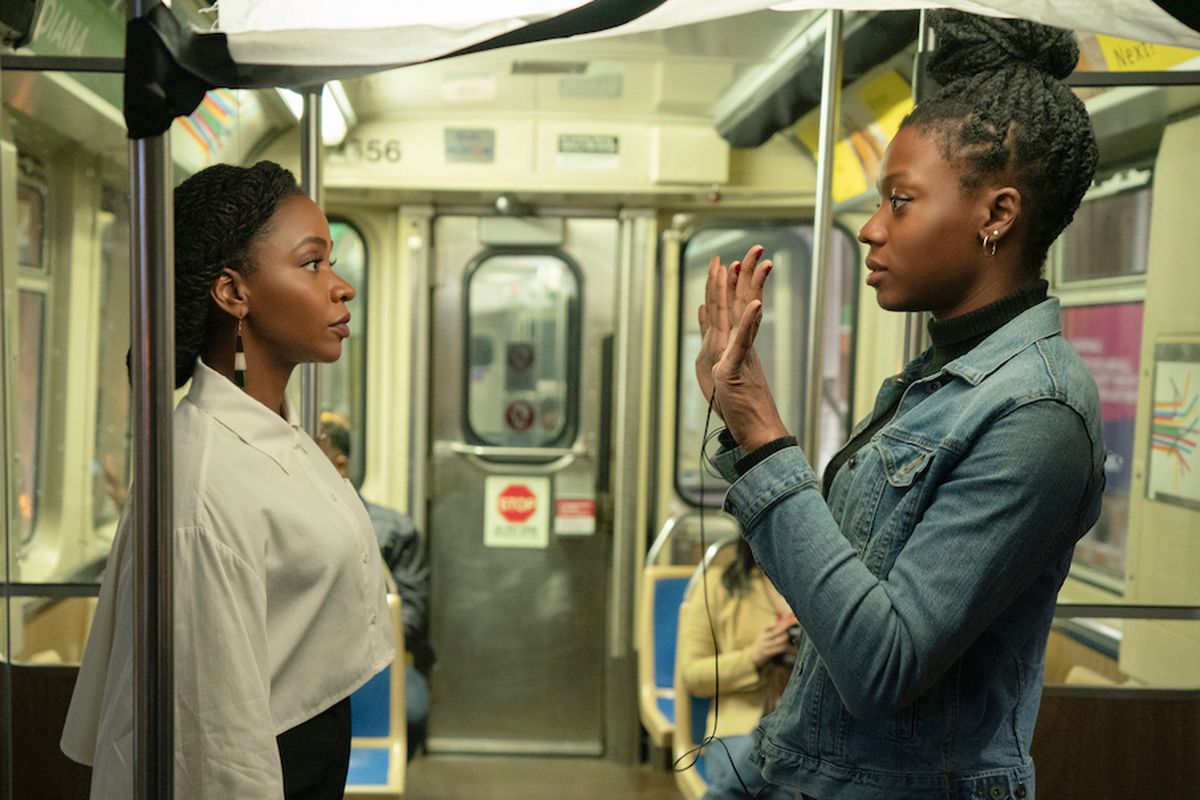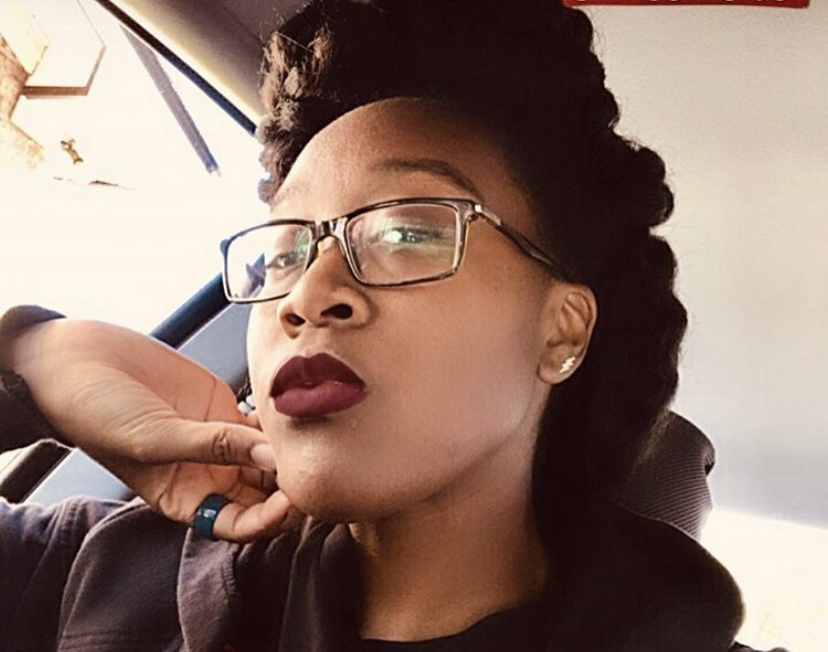
28 Oct Contending with ‘the Scraps’: The Fight for Direction of Black Women’s Horror Narratives
BY DANI BETHEA
The Candyman story of 1992 shows a housing project in decline with the threat of ‘urban renewal’ constantly in the rearview mirror; today, that renewal exists as hundred-thousand-dollar condominiums and a Target shopping center where the infamous high-rises once stood. In the span of a few years, 15,000 people living in 23 high-rise buildings located on a 70-acre plot were evicted and quickly bulldozed from history. However, all of Cabrini-Green has not been scrubbed from existence. The people and their political advocacy still survive. The flat Cabrini row-houses still remain, alongside other architectural structures. The Cabrini-Green of the newest film shows an area infiltrated by wealthy millennials and a bourgeois art scene that grossly revels in the mythology of ‘Candyman’ and the commodification of Black historical trauma. Candyman (2021) highlights this dynamic of erasure and displacement by examining the socio-economics of race and class and a radically altered Cabrini-Green. Moreover, the newest film explores “the ghosts that have been left behind because of gentrification.”
The horrifying subtext of the 1992 film is made text by explicitly stating in 2021 that “Candyman is not a he. He’s the whole damn hive.” Candyman has never been just an individual but something far more insidious and pervasive that has echoes across time, regardless of distance. The blood-stained grounds of Cabrini-Green are experiencing a cyclical haunting via systems of injustice that have created a conveyor belt of candymen. The image of the original Candyman flanked by a new legion of substrates, akin to a viral undead legion, is a macabre prognostication of where Black lives (especially men) could be derailed. Candyman is a figure that’s always in the crosshairs of White policing in both films. The first Candyman was Daniel Robitaille, who was a free Black man during the height of the antebellum period but suffered the far-reaching politics of Black subjugation across the United States. What’s critical about Candyman’s story is that it takes place in the north where the imagination rarely places such brutality or anti-Blackness. Controlling the economic, political, and social movements of Black people was vital to the terror campaigns of White supremacy in the north and the south.
Daniel’s ‘crime’ was having a consensual relationship with a White landowner’s daughter after the landowner commissioned his services for her portrait. The atrocity visited upon Daniel was calculated and in direct opposition to his upward mobility as a Black man and an artist. The entire White community made a gruesome example of him, molding him into a malevolent martyr, with artist’s hand and birth name ceremoniously sawn away. Minor spoilers, but the newest incarnation of Candyman is created via similarly grim circumstances. The film contained beautifully haunting imagery, phenomenal set pieces, and an edited runtime that seemed potent for a sequel. When the credits rolled, I still felt underwhelmed because of one absent component that the original film also seemed to miss: the import of Black women’s horror narratives.
Consistently in media, Black boys and men are the mourning vessels that so much of the trauma, pain, and horror of White supremacy is poured into. Their names, faces, and bodies are the ones seen repeatedly in literature, newspapers, television, and cinema. We know their stories because of a mixture of hyper-visibility — due to patriarchy — and misogynoir (race/gender bias against Black girls/women). There are very few pieces of fiction or media that explore (with an in-depth nuance) the Black girl ghost or Black woman spectre, beyond Toni Morrison’s Beloved (1987). In the years since her critical text, stories with horror elements have arrived that explore the lingering presence of the policing system within the United States, but few, if any, have explored the visceral circumstances that create the Black girl monster. Comic books, graphic novels, romance literature, young adult media, indie films, etc. have explored the Black girl or woman as monster, i.e., vampire or werewolf, but have not wrestled with the horrors of reality that are frequented upon Black girls that could transform them into something abominable and nightmarish. A reluctance, ambivalence, and non-meaningful engagement with the stories of Black woman as monstrosity has certainly left behind a void of incredible and necessary storytelling and mythology-making that could dutifully engage with the horrors experienced by the opposite gender—lest we forget the dearth of stories intersecting with and including non-binary and trans identities as well.
Courtesy of YouTube/Universal Pictures.
Thus, the importance of Nia DaCosta. The cultural assumption of men as presumptive faces of the horror brand or at the helm occurred before substantial buzz even began to swarm surrounding the film. Jordan Peele only co-wrote and produced, but was not the director of this sequel/reimagining. The campaign to ensure Nia DaCosta’s name is attached to the top billing of this film is still ongoing. Pressure is placed in hashtags, Twitter threads, etcetera to ensure that she is not erased or replaced, only uplifted. Nia DaCosta is drifting in a sea with only Kasi Lemmons (of Eve’s Bayou fame), at least regarding big-budget studio releases. There are Black women making independent short stories and short films, but rarely have they moved into the hands or eyes of production companies with substantial funds. They regularly receive initial fanfare and then wither away into obscurity in film festivals. In one weekend, Nia DaCosta’s film made back its entire budget in coupled domestic and international sales, making her the first Black female director with a #1 film at the box office. With all of this heralded praise and buzz surrounding the film, it was sobering to read about DaCosta’s experiences of on-set misogynoir.
I wasn’t necessarily stunned reading this because I’ve lived long enough to know that Black women have flaming hurdles to jump over on the regular, regardless of power or authority level. My vexation and fury was more so in the feeling of futility I experienced that Black women will always be navigating minefields. My disquiet was in knowing that Black women, even in their moments of triumph, will still be reeling with external horrors (on top of all the internal). I hate that Black women regularly have to be their own best friend and cheerleader when racism and sexism hinder their growth and development. This film could have been revolutionary and timely in its acknowledgment of Black girls and women who have been irreparably harmed by state violence and on the frontlines of protest and activism. Alas, they were sidelined. I don’t foist all of the blame on Nia DaCosta because she wasn’t the only writer or visionary on this film. Moreover, the greatest social and societal critique is: the vision of Black horror (monsters) is still overwhelmingly cisgender and male. With Black women directors, horror or otherwise, still trying to keep the Hollywood door from closing in their faces, I have to give so much grace to those that are still building a ladder to that proverbial glass ceiling. I just wonder if I’ll see it dismantled in my lifetime. There are so many radical stories we could be devouring from Black women in horror and it’s misfortunate for everyone at the table to be contending with the scraps.
One of the tentpoles of the horror genre is the written word. Before celluloid, the imaginative space of books was where one would frequently be privy to horrors unimaginable, or if you were a Black person living in the United States during enslavement or Jim Crow, nothing was out of the realm of the imagination. Black women authors have been exploring horror themes and settings in their work for more than a century, whether it was immediately apparent at first glance or not. For example, social justice writers such as Ida B. Wells and Zora Neale Hurston were also investigative journalists who documented barbarous things that have influenced many of the ways we engage with discussions of racism and white supremacy. Many of their books were spaces where the stories of Black people could be chronicled, actors given voice, and where whispered folklore could be unraveled into something cathartically profound. Today, Dr. Robin Means Coleman and Dr. Tananarive Due have shaped the intellectual underpinnings of horror, challenging its oftentimes racist misconceptions, and unveiling what the genre is truly capable of. Yet, many inside and outside of the horror space do not know their names or their impact on modern cinema or academia.
One recent depiction of a Black girl transformed into a monster showed the necessity of making spaces for these stories in the horror genre. Misha Green, director of the severely under-watched series Underground (2016–2021), directed and co-wrote a few episodes of the short-lived Lovecraft Country (2020) on HBO. I’ve written at length at where the show succeeded, stumbled, and oftentimes had a slippery time finding its footing, but beyond all of the fantastical imaginings and historical wrongs they attempted to right throughout the season, there was one episode that Misha directed and co-wrote, with Ihuoma Ofordire, that introduced the racist caricature of Topsy from Uncle Tom’s Cabin (1852) who haunts the young Black child character, Diana Freeman. This accursed image embodies the ‘black girl terror’, the smiling, dancing, devious devil, and the horrific inescapable scrutinizing White gaze upon Black girl children. Diana (Jada Harris) had been cursed by a white police officer to become an atrocious ‘pickaninny’ caricature. Poignant moments were interwoven into the episode that had pointed commentary about checking in with the Black girls in your lives about navigating trauma and grief, which were anchored by Misha Green’s willingness to explore the horrors of history made tangible. More thought-provoking and visually stimulating horror like this, please and thank you.
In closing, I am still searching for the gradations of horror films where Black women and girls are the martyr figures failed by their communities. I am still waiting for more Black women to have the opportunity to direct and write our Black and female-centric stories instead of these stories being continually erased and disappeared. Are our stories too painful and too shameful because they would expose the cracks that we slip through? Black horror films, with Black directors and casts, have always held a precarious position in the film industry and in popular culture. Their contributions rarely receive the praise, acclaim, or wider distribution that they truly deserve. Documentaries such as Shudder’s Horror Noire (2019) brought overdue exposure to the centuries-long contributions of Black auteurs and put their stories and the larger narrative of Black history in America into a much sharper focus. The documentary also highlighted the margins that Black women are still pushed into as characters and the ‘slim pickings’ for opportunities as directors. With Janicza Bravo slated to direct FX’s adaptation of Octavia Butler’s Kindred (TBA), there will finally be more than three Black women horror directors. After Nia DaCosta and Janicza, think hard. Who’s the next Black woman in the pipeline to this genre of film and why is there only space for one visionary at a time?
*Note*: I used The African American Policy Forum as a resource when writing this article.

Dani Bethea (she/they/them) is a Non-binary Grey-Asexual writer, weightlifter, and gardener from North Carolina. They are the former Editor-in-Chief of We Are Horror Magazine. Find them across an expanse of Medium publications, Gayly Dreadful, Uppercut Crit, and more. They have been a featured guest at Salem Horror Fest 2020: A Roundtable on Black Women’s Horror Aesthetics and Traditions, the University of Pittsburgh’s Summoning Candyman: A Discussion of the Cinematic Urban Legend, host of FrightGown 2021’s BIT and the Future of Trans Representation, and 2021’s Queen’s University Kingston-Ontario, Canada’s Witch Institute: Rachel True in Conversation with Dani Bethea. Find more of their published essay contributions in The Transploitation Book (TBA) and The Women of Jenji Kohan (March 2022). They will be a featured cast member in Mental Health and Horror: A Documentary (2022).

Sorry, the comment form is closed at this time.